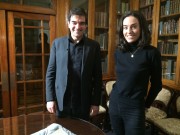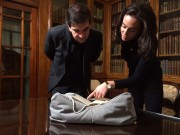EPISODE 2: THE IRISH LANGUAGE – PRESENTED BY FIACHNA O’BRAOINAIN – Monday 7 March at 8.30pm
Douglas Hyde was not only Ireland’s first President; he was also the first President of the Gaelic League. That organization played a central role in “advanced Nationalist” circles in the years leading up to the Easter Rising: indeed, five of the seven signatories of the Proclamation had been members of the League. Like Lady Gregory, Hyde may seem an unlikely figure to have played such a prominent role in the Revival – since he also came from an affluent and Unionist background. However, as well as being a poet and translator of Irish, Hyde wrote a crucial text for the Revival: “The Necessity of de-Anglicising Ireland”. Hyde was not greatly interested in politics, and, was not a member of any political organisation. When the Gaelic League became explicitly committed to the cause of Irish separatism in 1915, he found himself unable to continue as its President, and resigned. He became President of Ireland in 1938, and, although of advanced age and ill-health, served a full term. During that period, he gave rise to some significant controversies – up to, and including his own death in 1949.
FIRE IN THE BLOOD
A Series of four programmes on the Celtic Revival from February 29th at 8.30 on RTE One.
The Celtic Revival was a broad-based cultural movement whose stated purpose was to address many diverse areas of Irish life – literary, linguistic, visual and sporting. The purpose of this four-part series is to give a real sense of the breath of those ambitions and the scale of their impact on Irish society. Each episode will focus on one individual who played a central role in the Revival, and will be presented by a contemporary figure who can speak with credibility about that individual – assessing their lives, and the influence of their work. The Celtic Revival contained a number of outstanding and colourful individuals, but we have selected four whom we believe will provide insights to some of the major areas in which the Revival was involved.
EPISODE 1: DRAMA: LADY GREGORY – PRESENTED BY DERBHLE CROTTY
In some respects, Lady Augusta Gregory was a most unlikely person to play a major part in the Irish Literary Revival. She was born into Ireland’s landed gentry, and did not begin to write in earnest until she was middle-aged and a widow. A key event was her meeting with Yeats in 1896. This led to a close and intense relationship that lasted for the remainder of her life. For Yeats, she was “mother, wife, sister, friend” – and he relied on her for both emotional and material support. Together they founded, first of all, the Irish Literary Theatre – and then, in 1904, the Irish National Theatre Society, which became, in turn, the Abbey Theatre. In the light of recent events at the Abbey – when women writers were comprehensively ignored in the 1916 “Waking the Nation” slate of plays – it is timely that this remarkable woman is given full credit for her pioneering work in the creation of modern Irish drama – as a writer, translator, director and general manager of our national theatre. It is also appropriate that her profile is presented by Derbhle Crotty – a distinguished actor who, like Lady Gregory Derbhle has trod the boards of the Abbey Theatre. In her distinguished and ward-winning career, she has played many of the classic roles in Irish drama – both inside Ireland and abroad. She even played Lady Gregory some years ago in a Peacock production of a play by Colm Toibin. At present, she is playing “Juno” in the upcoming Gate production of O ‘Casey’s famous play.
EPISODE 2: THE IRISH LANGUAGE – PRESENTED BY FIACHNA O’BRAOINAIN
Douglas Hyde was not only Ireland’s first President; he was also the first President of the Gaelic League. That organization played a central role in “advanced Nationalist” circles in the years leading up to the Easter Rising: indeed, five of the seven signatories of the Proclamation had been members of the League. Like Lady Gregory, Hyde may seem an unlikely figure to have played such a prominent role in the Revival – since he also came from an affluent and Unionist background. However, as well as being a poet and translator of Irish, Hyde wrote a crucial text for the Revival: “The Necessity of de-Anglicising Ireland”. Hyde was not greatly interested in politics, and, was not a member of any political organisation. When the Gaelic League became explicitly committed to the cause of Irish separatism in 1915, he found himself unable to continue as its President, and resigned. He became President of Ireland in 1938, and, although of advanced age and ill-health, served a full term. During that period, he gave rise to some significant controversies – up to, and including his own death in 1949.
EPISODE 3: ART: HARRY CLARKE – PRESENTED BY CAMILLE O’SULLIVAN
Harry Clarke is undoubtedly Ireland’s greatest stained glass artist, and was a leading figure in the arts and crafts grouping within the Revival. His use of deep colours and delicate, elongated figures with closely defined features is highly distinctive. Although he was clearly influenced by British artists – such as Beardsley – the ‘Celtic character’ of his designs was acclaimed by leading members of the Revival such as George Russell and Yeats, and he explored the theme of Irish identity in many of his pieces – both in glass and in graphic work. During his short life, he completed over 160 stained glass windows, and is generally recognised as the outstanding visual artist closely associated with the Revival. However, his work was not without its controversies. He was commissioned by the Irish Government in 1930 to produce a window for the League of Nations building in Geneva. When it was completed, the piece was considered too “scandalous” for public display, and was placed out of public view in Government buildings.
EPISODE 4: SPORT: MICHAEL CUSACK – PRESENTED BY ANNA GEARY
Michael Cusack was a central figure in the Celtic Revival, who – along with Maurice Davin – founded the GAA in 1884 in Hayes’ Commercial Hotel in Thurles, County Tipperary. He was also active in the Gaelic League, was a provocative journalist in a number of radical Nationalist newspapers, and ran his own successful academy to prepare candidates for Civil Service examinations. Cusack was a keen sportsman who had played rugby and cricket in his youth, but he was also an ardent Irish Nationalist who had sympathised with the Fenian movement. By the late 1880s, he had become preoccupied with the idea of reviving Ireland’s indigenous sports. He realised that these sports needed to be codified. In order to do that, it was necessary to set up a national organisation – similar to England’s Football Association – and that led Cusack to call the meeting at Hayes Hotel. It gave birth to the “Gaelic Athletic Association for the Preservation and Cultivation of National Pastimes.” Cusack’s great contribution to the development of sport in Ireland was to introduce a range of activities which could be identified with Irish Nationalism, and to set up an organisational structure which extended to every corner of rural Ireland. However, Cusack was not without his critics. In the “Cyclops” episode of “Ulysses”, Joyce introduces “The Citizen” – a rabid Irish Nationalist, a racist and a virulent anti-Semite – whose character is largely based on Cusack.



